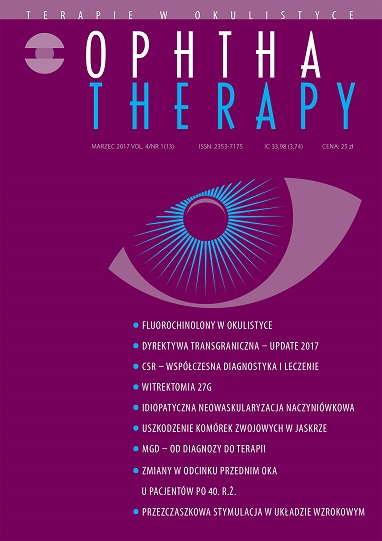27-gauge microincision vitrectomy – a current state of knowledge
Main Article Content
Abstract
Nowadays, vitrectomy is the primary method of surgical treatment of many retinal, vitreous and vitreo-retinal surface diseases. Over the last several years, we have witnessed minimization of surgical incisions in many areas of medicine, including ophthalmology. It may led to faster recovery, and fewer complications. The paper aims to present the current state of knowledge on the benefits of microvitrectomy, and in particular to present the advantages and disadvantages of the 27-gauge vitrectomy.
Downloads
Article Details

This work is licensed under a Creative Commons Attribution-NonCommercial-NoDerivatives 4.0 International License.
Copyright: © Medical Education sp. z o.o. License allowing third parties to copy and redistribute the material in any medium or format and to remix, transform, and build upon the material, provided the original work is properly cited and states its license.
Address reprint requests to: Medical Education, Marcin Kuźma (marcin.kuzma@mededu.pl)
References
2. Goldstein DJ, Oz MC. Current status and future directions of minimally invasive cardiac surgery. Curr Opin Cardiol. 1999; 14: 419-25.
3. Harell AG, Heniford BT. Minimally invasive abdominal surgery: lux et veritas past present and future. Am J Surg. 2005; 190: 239-43.
4. Koh CH, Janik GM. Laparoscopic microsurgery: current and future status. Curr Opin Obstet Gynecol. 1999; 11: 401-7.
5. Lundell L. Anti-reflux surgery in laparoscopic era. Baillieres Best Pract Res Clin Gastroenterol. 2000; 18: 272-7.
6. Oshima Y, Wakabayashi T, Sato T et al. A 27-gauge instrument system for transconjunctival sutureless microincision vitrectomy surgery. Ophthalmology. 2010; 117: 93-102.
7. Rizzo S, Barca F, Caporossi T et al. Twenty-seven gauge vitrectomy for various vitreoretinal diseases. Retina. 2015; 35: 1273-8.
8. Khan MA, Shahlaee A, Toussaint B et al. Outcomes of 27 Gauge Microincision Vitrectomy Surgery for Posterior Segment Disease. Am J Ophthalmol. 2016; 161: 36-43.
9. Mitsui K, Kogo J, Takeda H et al. Comparative study of 27-gauge vs 25-gauge vitrectomy for epiretinal membrane. Eye. 2016; 30: 538-44.
10. Byeon SH, Lew YJ, Kim M et al. Wound leakage and hypotony after 25-gauge sutureless vitrectomy: factors affecting postoperative intraocular pressure. Ophthalmic Surg Lasers Imaging. 2008; 39(2): 94-9.
11. Woo SJ, Park KH, Hwang JM et al. Risk factors associated with sclerotomy leakage and postoperative hypotony after 23-gauge transconjunctival sutureless vitrectomy. Retina. 2009; 29(4): 456-63.
12. Ibarra MS, Hermel M, Prenner JL et al. Longer-term outcomes of transconjunctival sutureless 25-gauge vitrectomy. Am J Ophthalmol. 2005; 139(5): 831-6.
13. Gupta OP, Ho AC, Kaiser PK et al. Short-term outcomes of 23-gauge pars plana vitrectomy. Am J Ophthalmol. 2008; 146(2): 193-7.
14. Fine HF, Iranmanesh R, Iturralde D et al. Outcomes of 77 consecutive cases of 23-gauge transconjunctival vitrectomy surgery for posterior segment disease. Ophthalmology. 2007; 114(6): 1197-200.
15. Scartozzi R, Bessa AS, Gupta OP et al. Intraoperative sclerotomy-related retinal breaks for macular surgery, 20- vs 25-gauge vitrectomy systems. Am J Ophthalmol. 2007; 143(1): 155-6.
16. Hsu J, Chen E, Gupta O et al. Hypotony after 25-gauge vitrectomy using oblique versus direct cannula insertions in fluid-filled eyes. Retina. 2008; 28(7): 937-40.
17. Taban M, Sharma S, Ventura AA et al. Evaluation of wound closure in oblique 23-gauge sutureless sclerotomies with visante optical coherence tomography. Am J Ophthalmol. 2009; 147(1): 101-7.

